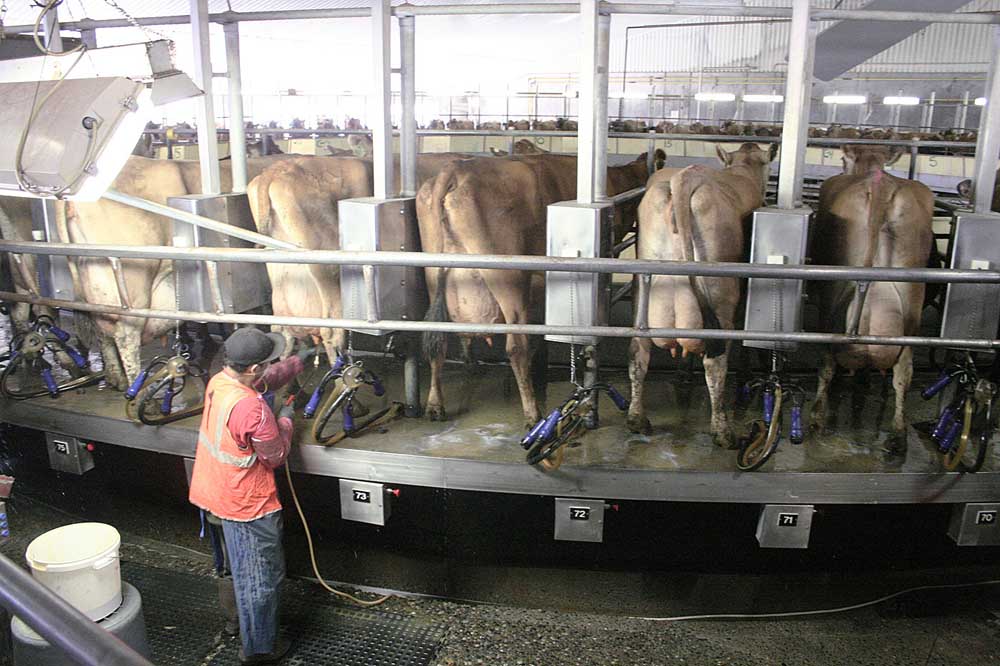Enhanced Oregon CAFO inspections clear key committee
Published 2:00 pm Friday, February 14, 2020

- A worker at a dairy milks cows on a carousel system. Oregon water regulators have rejected a petition to limit the stockwatering exemption in two critical groundwater areas.
A bill backed by Oregon’s dairy industry that would heighten inspection requirements for building large “confined animal feeding operations” has passed a key legislative committee.
At a Feb. 13 hearing, the Senate Committee on Environment and Natural Resources voted unanimously to approve Senate Bill 1513, which would require a preliminary and final inspection of large CAFOs before they begin operating.
Oregon’s farm and water regulators would also have to determine that large CAFOs — those with more than 2,500 mature dairy cows — have legal and reliable water supplies before animals are brought to the facilities.
The bill will now be considered by the Senate Rules Committee, which isn’t subject to legislative deadlines affecting other committees.
Currently, CAFOs are inspected by the Oregon Department of Agriculture as they’re constructed and start operating, but there isn’t a specific requirement that a facility receive approval before being populated with animals.
The notorious wastewater problems at Lost Valley Farm near Boardman, Ore. — which eventually shut down during bankruptcy proceedings and was sold in 2019 — spurred a similar proposal that didn’t gain traction last year.
Oregon’s dairy farmers strive to be good neighbors and the Lost Valley operation didn’t live up to that standard, said Paul Snyder, executive vice president of stewardship for the Tillamook County Creamery Association.
“That was a tragedy for this state,” Snyder said during an earlier legislative hearing.
The dairy industry doesn’t believe the current CAFO system is broken but acknowledges that it could be enhanced, so it’s willing to support SB 1513 as long as it only applies to new facility construction, he said.
“We don’t want to be overburdened as an industry by one bad actor, but it does deserve a response,” Snyder said.
Applying the two-phase inspection system to expanding CAFOs, as proposed under one amendment, is unnecessary because they already work closely with farm regulators, he said.
That sentiment was echoed by dairy farmer Bobbi Frost of Creswell, Ore., who said the state’s dairy farmers are in daily contact with Oregon Department of Agriculture inspectors when expanding their operations.
“We have a relationship and he understands our farm and the challenges we’ve had,” Frost said.
The amendment that would have required expanding CAFOs to abide by the new inspection rules wasn’t adopted by the committee.
The regulatory changes proposed under SB 1513 were roundly criticized by environmentalists as being insufficient, however.
“It just doesn’t go far enough,” said Scott Beckstead, senior state director for Oregon at the Humane Society of the United States, during an earlier hearing.
Beckstead said lawmakers should instead impose a moratorium on any new large CAFOs until it overhauls the regulatory system to protect animal welfare, the environment and small family farms that are struggling to compete.
“We can’t claim to be serious about protecting our environment and fighting climate change when we’re rolling out the red carpet to these massive factory farms,” he said.
Brian Posewitz, staff attorney for Waterwatch of Oregon, said a coalition of environmental groups would prefer a moratorium on large dairies but acknowledged that SB 1513 would be an upgrade to the current regulatory system.
Specifically, Posewitz said the bill was a “marginal improvement” to the CAFO permit system because regulators would need to verify that new facilities have sufficient legal water. However, he called on lawmakers to pass an amendment that would expand on the proposed water regulations.
That amendment, which did not win approval from the committee, would have required regulators to specifically review a full range of water uses at CAFOs, including stock watering, crop irrigation and machinery washing.
“All those water demands add up to the water demands of a medium-sized city,” Posewitz said.






